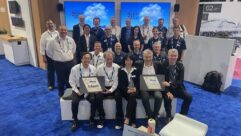
Part of the hit international franchise, ‘The Voice Australia’ debuted in 2012 attracting millions of viewers to the show, which culminates in a six-week live competition phase leading to the grand finale. Season 6, which wrapped up in July 2017, used a rack full of d3 4x4pro media servers with DVI VFC cards (16 outputs each) to master the show’s video complexities.

“When I have a choice of server there is only one I choose, and that is d3,” says Steve Cain, Head Engineer and Media Server Specialist at Technical Direction Company (TDC), Sydney. “The flexibility, reliability, features and power of the system are exactly what I need to deliver this show, week after week, day after day. We work within very tight time frames; each week the show is challenged to offer bigger and better show moments than the prior week. And, similar to a lot of live productions, there are endless changes to the creative process and show orders. No other system I’ve used can stand up to this epic demand.”
For Season 6 the show had what Cain calls ‘a base rig’ consisting of “many LED screen elements and control room set ups linked back into Kinesys automation motor controllers, OB truck feeds, the animation studio and the lighting system. Each week, after all heads of departments met with the creative producers, we designed a number of ‘weekly show specials’ specifically for a song or act. This could be anything: additional LED screens, four to six projector mapped blends, moving head projectors, screen surfaces – most of which had to be rolled on, lined up and then struck in a three to four minute live commercial break with producers counting you down to ‘back on air,’” he recalls.
Given those demanding parameters Cain finds the 4x4pros act as “a one-stop shop with everything I need built into one operating platform. When I’m in the studio, I’m running the server a number of ways simultaneously: from a network of grandMA2 lighting consoles, reacting to live incoming automation data, on and off chasing of timecode, bouncing cues from my phone for producer walkthroughs and down timeline programming. This, combined with low latency capture cards, plus a Notch playback license, is all in one box on a fantastic visual GUI. What more could I ask for?!”
Cain believes that d3’s previs capabilities are “one of the best advantages d3 can offer over other systems. I use the visualization of the GUI extensively to design the ever-changing system from week to week. I can prove or disprove concepts ahead of studio time and plot all the camera positions so the show producers can see what each element will look like from actual camera positions. We do all of this in our purpose-built d3 Studio at our TDC head office,” he explains. “It saves us a lot of time, hassle and money each week.”
During Season 6 he used a number of features of d3’s key features. “SockPuppet worked with my grandMAs, QuickCal and Deformation Layers allowed me to line up six projectors in three minutes, and Multi-Transport ran multiple timelines simultaneously,” he says. “The unique way d3 does output mappings” also proved helpful and “the 10-gig network and Media Versioning uploaded and managed an abundance of content each day.”
Cain reports that, “even though I was running a output machine and understudy system with automatic failover switching of our complex matrix system, I have never had to use it to date. d3 runs 100 percent every day, week after week.” Nevertheless, “support from d3 has always been second to none. They have always allowed me to get the full potential out of the system” he notes.
It’s not only professionals like Cain who are excited about deploying d3’s pro range servers. “Our clients love it,” he says. “They can throw pretty much anything at me at any time, and it can be done! They also love the visualisation of the GUI and the fact that I can ‘hold’ the outputs live-to-air to tweak a last-minute change without ever needing to go to black.”
In addition to ‘The Voice Australia’, TDC has used d3 media servers on some eight television shows annually, including the X-Factor, This Time Next Year, Accidental Heroes and Little Big Shots.
The voice is produced by ITV Studios Australia;
Artistic Director : Leanne Cherny
Technical Production Manager and Lighting Operator: Ian Anderson
Lighting Director: Hugh Taranto
TDC Technical Project Manager: Anthony Pellizzari
TDC Video Crew: Steve Cain, Chris Irvine, Katie McIntosh
About d3
d3 is the world’s first fully integrated visual production system for video professionals, combining a real-time 3D stage visualizer, timeline, video playback engine and projection mapping tools into one product. d3’s unique integrated workflow assists the designer at all stages of the project, from pitch through development to final delivery. For more information visit www.d3technologies.com.










